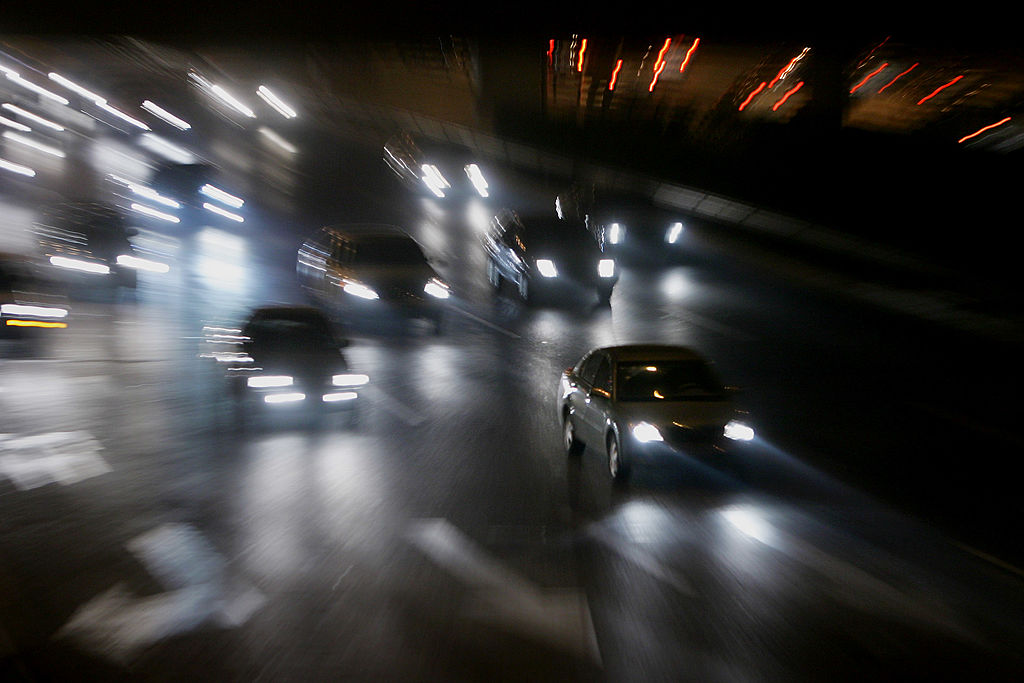Defector has partnered with Discourse Blog to bring you a taste of their work. They write good shit that we think you’ll like—and they’re offering Defector readers 25% off all annual subscriptions. Click here to get yours.
This piece was originally published on Discourse Blog on Dec. 15, 2021.
I’m currently on a short holiday trip to visit my parents, who live in rural California. In New York, I don’t drive much—usually only a road trip or two each year, maybe a moving truck or friend’s car on occasion. But at home, I spend a lot of time on the road. Getting to most of my high school friends’ houses requires a 30-45 minute drive down out of the foothills and into town. On Friday, I was driving back from a buddy’s house at night, and noticed that now, for some reason, I was having a consistent problem getting absolutely blinded by the headlights of every oncoming car. So I did what many people in a situation of minor annoyance do: I tweeted about it.
It turns out I am not alone! Many, many people also agree that headlights these days are way too bright! I feel foolish now for leading with the “maybe a controversial opinion” bit, but at that point, I had done zero research into the pros and cons of modern headlights. I had no idea whether this was a statistically safer development. I was simply commenting on the fact that when you are driving home late at night on a two-lane highway the big Jeep lights make your eyes hurt.
Still, the fevered reaction to this tweet convinced me to do a little research, which very quickly turned up many already-published articles about why the headlights are too bright, how the headlights got too bright, and what people are doing about the headlights being too bright. (Personally, I am tweeting, and now blogging, about the headlights being too bright.) So let’s find out, together.
High up in the Google search rankings is this 2021 article from the New York Times, which is as New York Times-y as it can possibly be (A central character! From the Midwest! Dire warnings!) for a story that aims to answer a very simple question (Why light hurt eye?) Here is a handy excerpt:
Advances in lighting technology have improved nighttime driving for many, but the introduction of brighter lights that also sit higher on S.U.V.s and pickups has given rise to widespread criticism that headlights have become overpoweringly intense.
“If you’ve not been affected by them, you will be,” Mr. DeVries said, referring to LED headlights. “You wait. You’re next. It’s only a matter of time.”
Mr. DeVries was right!! I was next! But there was also a very useful two-paragraph history of headlights:
“Sealed-beam” headlights were used from the 1950s through the 1980s, and generally offered poor light output. Halogens, with tungsten filaments and better output, appeared in the late 1980s and early 1990s.
High-intensity discharge lights, which cast a bright glow that approximates the spectrum of daylight, came in the late 1990s and early 2000s. In the 2010s, LEDs became popular because they were longer-lasting, energy-efficient and perceived by automakers as sexy and modern.
This is good. We’re getting somewhere. My search also led me to this extremely well-researched article on a delightfully named website called MotorBiscuit, which gave me the following (emphasis mine):
Nowadays, though, Advanced Auto Parts reports headlights come in 3 electrically-powered varieties: halogen, LED, and high-intensity discharge/xenon. Halogens are basically upgraded versions of the traditional incandescent lightbulb, using a glowing filament to provide light. HIDs, though, use charged xenon gas (hence the name), and LEDs use electrical diodes.
HIDs last several times longer than halogens, and LEDs, because they draw less power, last even longer than that. Both are also brighter than halogen bulbs. Light brightness is measured in lumens. According to Donut Media, the typical halogen bulb puts out 1300 lumens of light. The average LED puts out 1600, but an HID emits 3000. There are even laser headlights on the horizon that can put out up to 6400 lumens.
I’m not a lumens guy myself but 3,000 seems like a lot! MotorBiscuit also explains that LEDs and HIDs also have a much higher color temperature of light (they’re the ones that look white or blue) and are therefore much harder on the eyes.
The other major problem that kept cropping up in articles, and in many, many replies to the tweet, is that modern SUVs and trucks are simply too high off the ground, so their lights are shining directly into smaller car drivers’ eyes (for transparency, I usually drive my parents’ 2016 Toyota Prius, which does have blue-ish lights, but they are low to the ground, so I’m only half of the problem here). The issue I see with this is that we are not going to change the light-level problem without drastically regulating or phasing out large trucks and SUVs, which seems almost more impossible to do than banning guns in this country, so I think we can move on.
So what’s the solution? Well. My research leads me to conclude that we have to do something about these absurd HID bulbs and probably the LED ones, too. More cursory research suggests that they are actively making the roads less safe (I am vindicated, in case you can’t tell). LED lights are pretty easy to make any color, so it stands to reason that you could have lights that combine their energy-saving benefits with, you know, not blinding you with blue beams of death. There are more sophisticated solutions, like auto-dimming technology, proper positioning of bulbs, etc, but I am not going to get into that because what do I look like, a car guy to you? This far into the blog and you are still under the impression that I am a car guy? I just confessed to driving my dad’s Prius around man come on.
Anyway. The good news in all of this is twofold. One is that my tweet was correct. Two is that there may actually be concrete change in this area soon. As MotorTrend (not as cool as Biscuit, sorry) reports, U.S. regulations around headlights have been woefully behind the times for decades, but might get a significant upgrade as Joe Biden’s new infrastructure bill is implemented. What this actually means is complicated, but I think this is the relevant bit (from MotorTrend):
As reported by The Drive, section 24212 of HR 3684—the Infrastructure Investment and Jobs Act and signed into law on November 16, 2021—is simply titled “Headlamps.” and states, “Not later than 2 years after the date of enactment of this Act, the Secretary shall issue a final rule amending Standard 108.”
Standard 108, it turns out, is the law that governs headlights, and it has not been updated in years. MotorTrend explains that this, specifically, is what has been preventing us from getting technology like Europe’s “Adaptive Dimmer Bulbs” which do exactly what they sound like, and then some, according to the Drive:
Elsewhere in the world, headlights can do things like dim around oncoming traffic while painting a high-beam level of lighting in your lane, or turn down the brightness on some blinding reflective signage.
What the—that sounds awesome. However, right now lights like this are illegal in the U.S., which seems dumb, but will hopefully be rectified in a time period of no longer than two years. Two years! Give us the European dimmer bulbs now! Better yet, make them yellow again! As we have clearly established in this blog (and in all the other blogs referenced), our lights are bad. I was right. Thank you. If this blog also gets shared a quarter of a million times, that would be great. Drive safe out there.






